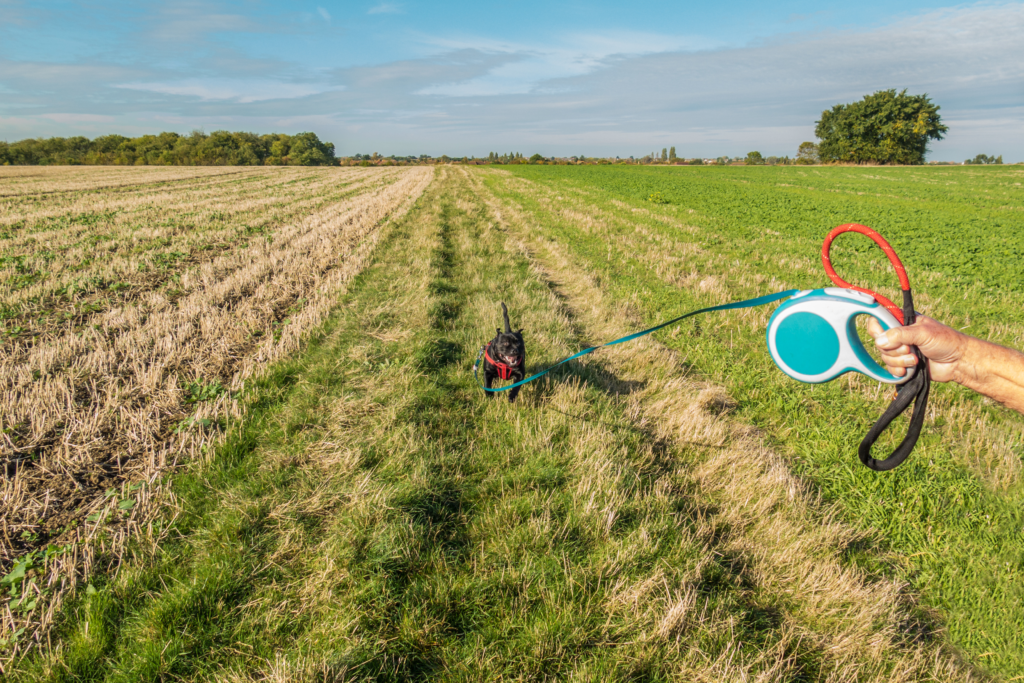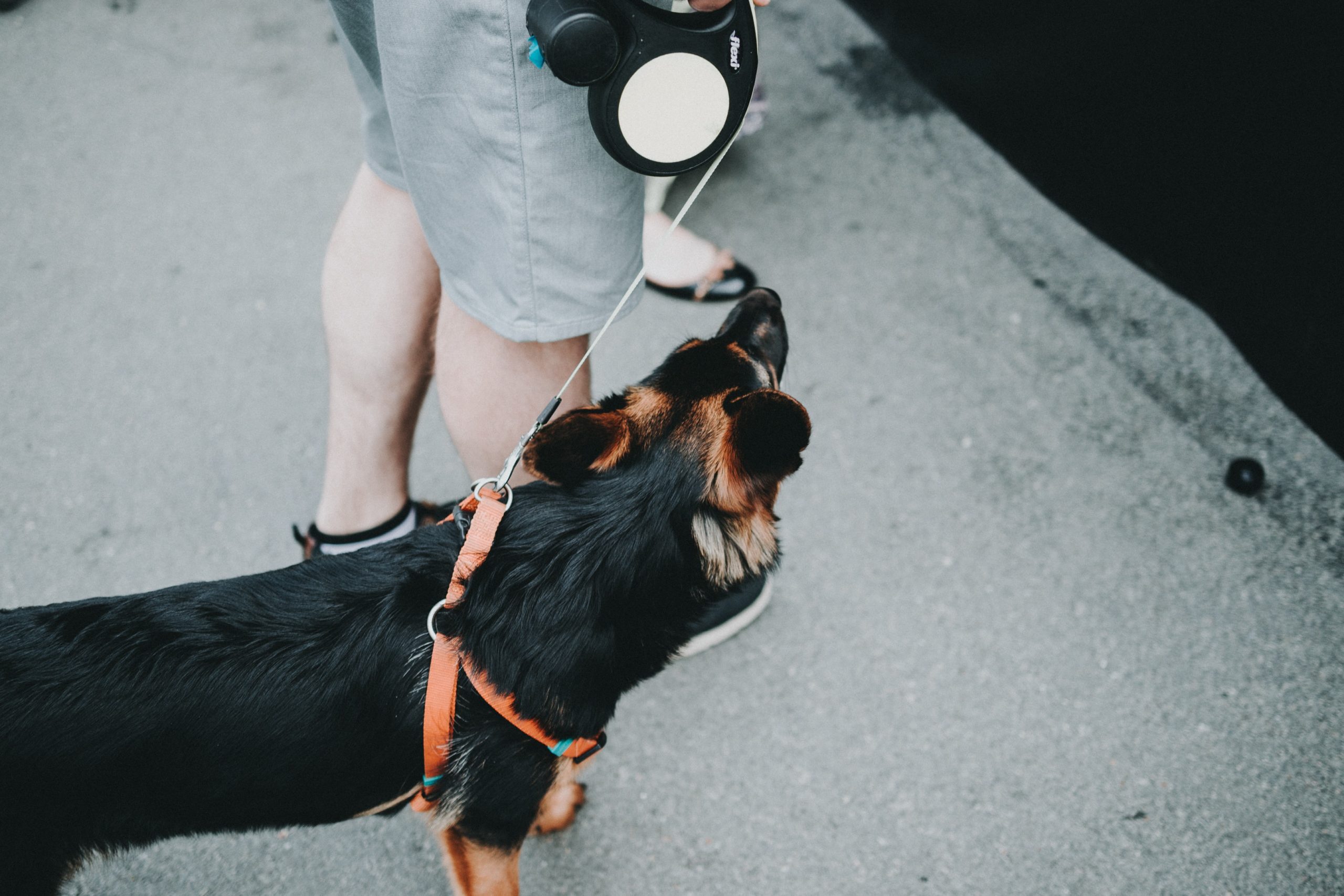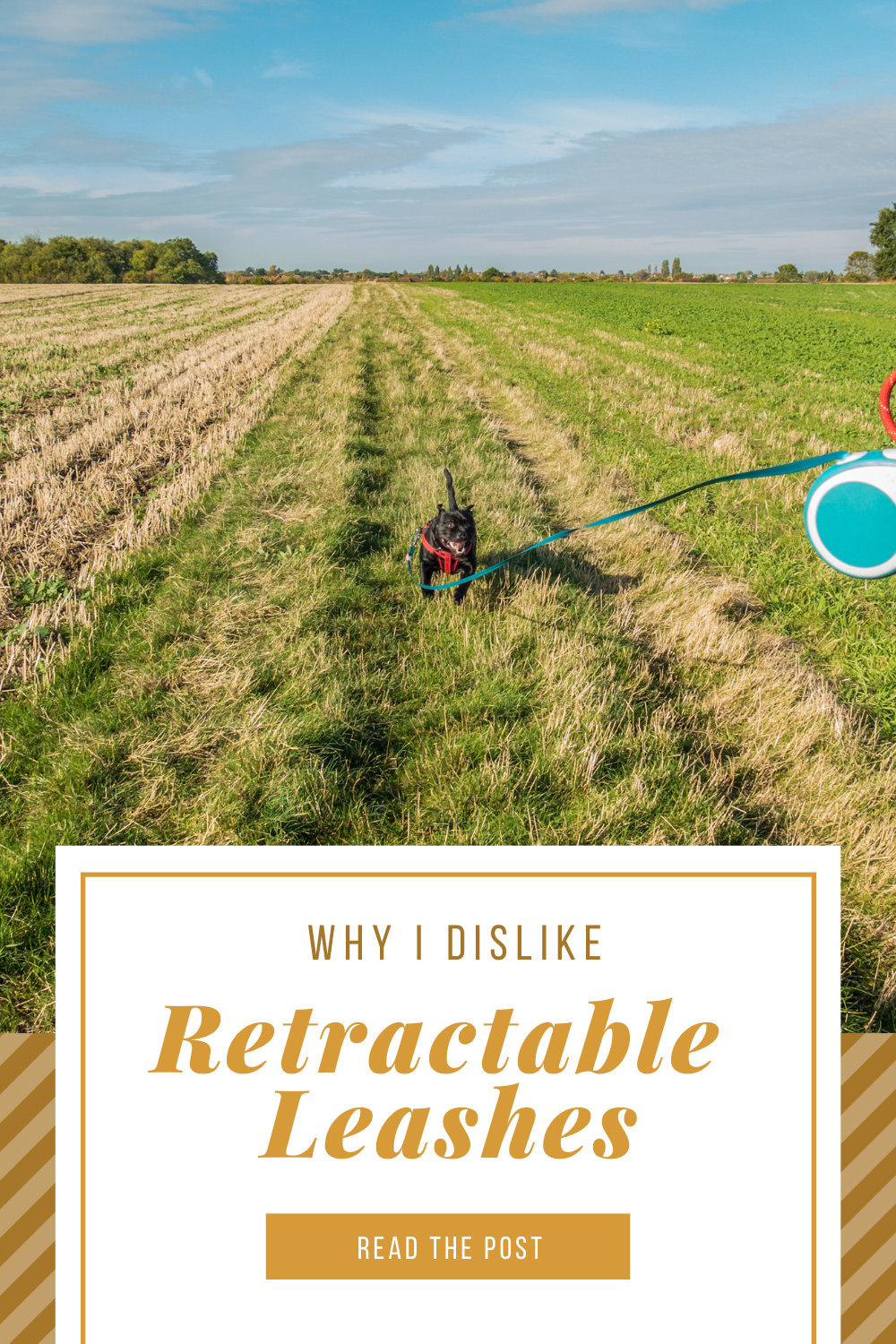Retractable leashes are designed to give a dog freedom while maintaining the security of being on-leash. Most standard leashes are 4-6 ft long, while retractable leashes often extend 10-26 ft. They are popular because owners feel they give the dog more freedom to sniff and poke around on walks. In theory that sounds great! So, why don’t I recommend them?
I recently went to a clients house to assess their reactive dog. The owner met me at the front door with their dog on a retractable leash. Within seconds the dog spooked, ran a few laps around me, and the nylon cord tightly wrapped around my shins. Even with pants on that thin cord hurt!
Not only is the potential for injury is higher, but there are many other reasons I don’t recommend them.
In this article we will cover:
- Why I don’t recommend retractable leashes
- Important things to consider if you want to use one anyways

Why I don’t recommend retractable leashes
1. Retractable leashes can teach dogs to pull
Retractable leashes are constantly putting tension on the dog. The way they work is that the dog has to pull (even just a little bit!) to extend the leash. If the dog wants to go sniff something further away, they need to pull to get to it.
Pulling on leash is one of the top 3 reasons a client calls me. To get a dog to loose leash walk we teach them that pulling does not get them what they want. Retractable leashes do the exact opposite! Pull= freedom.
2. Retractable leashes can cause injury
Retractable leashes are usually a thin cord wound around a spring-loaded device housed inside a plastic handle. The potential for injury for both you and the dog is much higher than a standard leash. Why?
If a dog spots something they’re interested in, the long length of the leash can allow them to gain high speed as they run. The impact on your shoulder of stopping a full run when they get to the end of the leash can cause pain & injury. It can also harm the dogs neck and spine.
Retractable leashes also result in a surprising amount of injuries for the owner every year. These range from falls, burns, lacerations, or even amputations from the thin cord.
3. They provide too much freedom
Often people who wouldn’t trust their dog off leash allow them to explore up to the full length of a retractable leash. For many hazards, your dog being 26 ft away may as well be off leash!
The extreme length of retractable leashes gives dogs unsafe levels of freedom. They could easily chase a squirrel into a busy road, or have an opportunity to greet an aggressive dog while you’re >20 feet away.
If the need for control arises it’s very difficult to quickly get it. Injuries often occur when owners grab the cord to pull their dog back.
4. The handle can spook dogs
The handle of retractable leashes is often a bulky plastic piece that’s more easily pulled out of an owners hand.
If you drop a standard rope, leather or biothane leash it’s quiet when it hits the ground. The plastic retractable leash handle makes a lot of noise however. If the dropped leash spooks the dog and causes it to run (or if you dropped it because your dog was already running at something and pulled the leash from your hand) the plastic handle makes a lot of noise as it bounces along behind your dog. This can cause your dog to spook/think it’s being chased and bolt away.
5. Retractable leashes can break
The thin cord of a retractable leash can snap if a strong dog takes off at full speed. Now the dog and whatever it was chasing could both be in danger.
For all these reasons, I don’t recommend retractable leashes.
Retractable leashes are intended to be a hybrid of on/off leash, but they end up being the worst of both worlds.
I have 3 different leashes for my dog: a 6 foot leash I use for most walks, a long line for training/extra freedom, and a hands-free waist belt leash for jogging. I feel it’s better to have various leashes specifically suited for one job rather than trying to use one leash for all jobs.
In situations where you need control of your dog, I suggest a standard 6 foot leash.
If you want your dog to run and have more freedom you should train their recall and let them off leash completely (in places safe to do so).
In situations where you might want your dog to have more distance from you but remain on leash (such as recall training, learning to swim, parks, or hiking) I suggest using a biothane long line.

What if you want to use one anyways?
If you’ve read the reasons I don’t recommend a retractable leash and decide you still want to use one anyways, please use it properly!
1. Use it with proper equipment
I do not suggest the use of choke or prong collars ever, but it’s very important that you do NOT use one with a retractable leash. You should also avoid using a head collar, anti-pull harness, or martingale collar with the retractable leash.
All of these tools are designed in various ways to give you more control over your dog and decrease pulling, whereas the design of the retractable leash gets your dog to pull for more freedom. Talk about mixed signals to your dog!
If you’re going to use a retractable leash only use it with a flat buckle collar or comfortable back clip harness!
2. Choose the correct weight limit
Most retractable leashes come with a suggested maximum weight for the dog. Pay attention to it! If you choose one too light the leash is more likely to break. If your dog is close to the maximum, size up.
3. Don’t buy the longest option
If you’re going to use a retractable leash, buy one that’s 16 ft or shorter. If your dog is >20 feet from you and not easy to pull back (like they are on a long line) they may as well be off leash! A shorter length is less likely to result in injury for you or your dog.
4. Make sure it has a locking feature
Most retractable leashes come with a locking mechanism, but make sure yours does. You want to be able to keep your dog close to you in busier locations, while letting them in/out of a vehicle, or in any spot with hazards that they may chase.
I don’t recommend retractable leashes, but if you’re going to use one please do it as safely as possible!
Happy training 🙂
Disclosure: Happy Hounds uses affiliate links. Purchasing with these links will not cost you any extra, but I get commissions for purchases made through these links. Affiliate links help me to continue to offer free resources & blog posts. I would love if you used them!


+ show Comments
- Hide Comments
add a comment